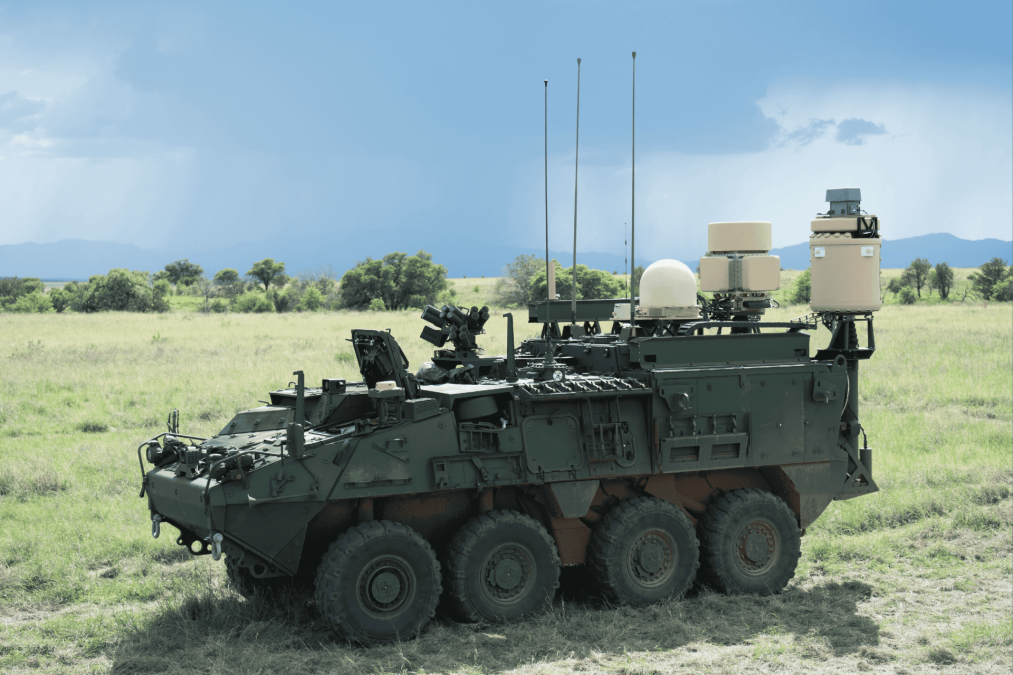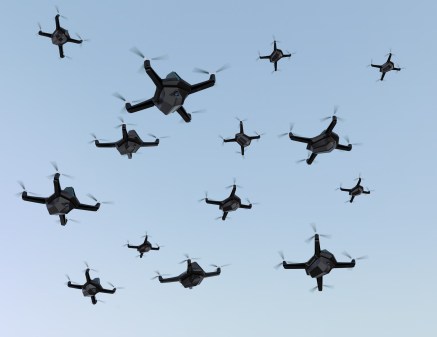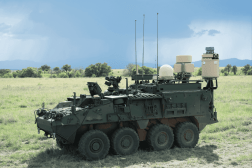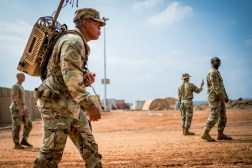Army moving out on new short range and long-range electronic warfare platforms

ABERDEEN PROVING GROUND, Md. — The next year will be critical for the Army as it looks to both field and develop two electronic warfare capabilities in tandem that will provide critical jamming and sensing tools.
The first such capability, the Terrestrial Layer System-Brigade Combat Team (TLS-BCT), is undergoing an important operational assessment that will be a critical step in moving out toward fielding.
TLS-BCT is the first brigade-organic integrated signals intelligence, electronic warfare and cyber platform that will first be mounted on Strykers.
“We’re looking at September of 2023 as the mark on the wall for operational assessment. This is really going to be a trailblazing event for us,” Maj. Derek Vanino, assistant program manager for Terrestrial Spectrum Warfare within Program Executive Office for Intelligence, Electronic Warfare and Sensors, told reporters during a visit to Aberdeen Proving Ground on Aug. 30. “We’re already working very closely with the test community, having advanced discussions about our operational assessment and what that means for this acquisition decisions that are going to emanate from that from the operational assessment.”
Lockheed Martin was awarded a $58.8 million contract in July to pave the way for TLS-BCT to be delivered to soldiers in 2023.
The September operational assessment is a “steep runway” from the award last month in terms of getting everything aligned, officals said. They expect to do a configuration on an actual vehicle in the June timeframe before transporting them to the test location.
This test won’t be the only place the Army will collect data informing the final acquisition push, officials said, pointing to a variety of additional demonstrations of the technology between now and the end of 2023.
Officials explained the main platform for TLS-BCT currently is a Stryker, with plans to outfit other types of brigades such as armored and infantry. For armored units, the Army is targeting the forthcoming Armored Multi-Purpose Vehicle (AMPV), which is the replacement for the M113 family of vehicles, though that effort is contingent on the ongoing experimentation with the Strykers.
“The AMPV’s direction is really — a lot of that’s going to be contingent on the Stryker, because we’re really, as we view it, it’s a similar mission package,” Vanino said. “The performance of the — of the Stryker at [operational assessments] is going to be a key driver also of the AMPV and a key driver of the timelines associated with that as well. That’s really how I’d message that is Stryker’s going to be the trailblazer, then AMFV is going to follow.”
The Army does have funds to do some level of design and possible integration work for the AMPV in fiscal 2023.
Infantry units are a bit more tricky, Vanino said, with the Army waiting for further experimentation.
The priority for these units will be a manpack requirement for TLS-BCT that the Army is still developing. Soldiers will be able to take a backpack off the platform for dismounted operations.
“That’s an area where we’re continuing to look at what’s available in that form factor versus what the desirements are,” Vanino said. “With manpack, obviously, it has the potential to become quite cumbersome, get quite heavy and then you’re trading some of that mobility for capability. We’re rapidly scoping what the requirements of the end user are going to be with the manpack with an eye towards moving forward with a — with a solution for that.”
Officials noted that regarding the cyber capabilities, those are more suited for the 915th Cyber Warfare Battalion and its expeditionary cyber teams.
These teams will augment brigades and lower formations conducting tactical cyber and electronic warfare operations by using specialized equipment that can plug into what the brigade already has.
“All platforms are being developed to have the ability to do an RF delivery of cyber effects,” Willie Utroska, deputy program manager for Electronic Warfare & Cyber at PEO IEW&S, told reporters.
Deep sensing
In addition to the brigade system, the Army is also working on the TLS-Echelons Above Brigade capability that will be designed for higher echelons that will need to monitor and sense the battlefield across greater distances than lower, more tactically focused echelons.
A new start in fiscal 2022, the TLS-EAB program recently awarded two companies — Lockheed and General Dynamics Mission Systems — to do design work, which includes software infrastructure and even vehicle design worth approximately $15 million over an 11-month period of performance.
For phase two, one of the companies will receive an award for prototype development.
Officials have said that this version of the program will likely be less integrated than its brigade counterpart.
“The TLS-Echelon Above Brigade system, which will provide similar capabilities for division, corps and multi-domain task forces will also be fielded at echelon, likely not as integrated based on the ranges and complexities, but nonetheless we need those capabilities at all echelons,” Lt. Gen. Laura Potter, deputy chief of staff for intelligence, G2, said at an event hosted by the Potomac Officers Club on Aug. 24.
This is likely given that the ranges covered for these echelons makes operations like electronic attack more difficult.
“When you get up into the theater level and the corps level, those ranges, perhaps it’s not as important to have as much effect for electronic attack,” Maj. Joseph Fink, assistant program manager for Terrestrial Spectrum Warfare managing the program at PEO IEW&S, told reporters at Aberdeen. “Maybe it is, maybe it’s not. We’re going to figure it out in phase one. It’s an exploratory phase for us, we’re really going to use the industry partners and their creativity and existing proven capabilities that could be integrated [and] model understanding to find out what is realistic in the terrestrial” capability.
More power will be needed to affect those ranges from an electronic attack perspective, and that will be something officials will assess if they need to.
“That’s the power of prototyping. We haven’t determined what the platform is going to be and platforms can differ between echelons,” Utroska said. “We’ve decided what the BCT is going to — going to get, but from a division, corps and multi-domain task force, the division may be more mobile than the corps … The power of prototyping is determining that mix. Is it a vehicle and a trailer? Is it one vehicle, is it two vehicles? That’s what we’ll figure out in the next year of prototyping.”
While there are different signals of interest at these higher echelons and electronic attack might not be possible or even needed there, officials said all these systems will work together as a family.
“When you look at what we have to get the threat, not one system can do it all. You have to combine techniques, a combined system. An example would be using the TLS-EAB in conjunction with an MFEW-Air Large,” Utroska told reporters during a separate trip to Aberdeen Proving Ground in August, citing the Army’s forthcoming aerial jamming pod.
Resourcing for these Terrestrial Layer Systems will come from electronic warfare platoons within brigades and electronic warfare companies at the division and corps level the Army is in the midst of building.
Currently, the Army has stood up 15 electronic warfare platoons at the brigade level with 16 additional platoons remaining until full implementation by 2027, according to a spokesperson from the Cyber Center of Excellence. The EW companies at the corps and division level will be built in 2023 with corps completing by 2027 and divisions by 2029.
Additionally, the Army has completed implementation of five Special Forces Group electronic warfare platoons and a Ranger Regiment cyber and electromagnetic activities company.
Officials said prototyping and experimenting will help determine the final force structure for these.






